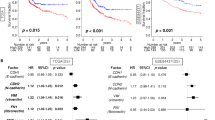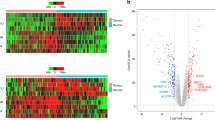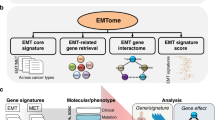Abstract
A tissue microarray analysis of 22 proteins in gastrointestinal stromal tumours (GIST), followed by an unsupervised, hierarchical monothetic cluster statistical analysis of the results, allowed us to detect a vascular endothelial growth factor (VEGF) protein overexpression signature discriminator of prognosis in GIST, and discover novel VEGF-A DNA variants that may have functional significance.
Similar content being viewed by others
Main
The clinical behaviour of gastrointestinal stromal tumours (GIST) is notoriously difficult to predict. The prognostic and therapeutic significance of KIT mutations is somewhat contradictory (Ernst et al, 1998; Lasota et al, 1999; Moskaluk et al, 1999; Taniguchi et al, 1999; Lasota et al, 2000; Hirota et al, 2001; Wardelmann et al, 2002; Koay et al, 2005). Therefore, it appears that new molecular indicators of prognostication are needed. Tissue microarrays (TMA) is a high-throughput method for the analysis of large numbers of formalin-fixed, paraffin-embedded (FFPE) materials with minimum cost and effort (Kononen et al, 1998). Here, we applied the TMA technology to analyse protein expression in GIST. The results were analysed with an unsupervised, hierarchical monothetic cluster statistical method. Those biomarkers with strong clinical significance were tested for mutation status by both PCR-denaturing high performance liquid chromatography (DHPLC) and direct sequencing. By doing so, we identified a VEGF-A protein overexpression signature as a statistically significant predictor of malignancy, discovered VEGF-A ligand DNA variants in GIST, and provided other possible targets in future design of anti-VEGF-directed therapy against GIST.
Materials and methods
We used 50 archival paraffin blocks (Department of Pathology, National University Hospital, Singapore), including 15 cases of GIST with a benign outcome, 17 with a malignant outcome (13 primary neoplasms and four metastases), 10 with no available clinical follow-up, and eight gastrointestinal mesenchymal neoplasms other than GIST, such as leiomyoma (n=5), leiomyosarcoma, neurofibroma and schwannoma (one of each). The mean clinical follow-up was of 39 months. The overall clinico-pathological characteristics are summarised in Table 3. No chemo or radiotherapy was given to these patients. All the gross and histopathological parameters classically associated with malignant potential were analysed. The findings were similar to those reported in other series (data not shown) and, in themselves, are considered insufficient for single-case prognostication in the clinical setting.
After case review for diagnostic confirmation, the TMA was constructed as reported elsewhere (Zhang et al, 2003a; Salto-Tellez et al, 2004). The 22 antibodies used are 34 BE12, AE 1/3, Bcl-2, CAM 5.2, CD10, CD117, CD34, c-erbB2, CK7, CK20, Desmin, Flk-1, Flt-1, Hep Par1, Ki-67, MNF 116, p53, PCNA, S100, SMA, VEGF-A and Vimentin. Table 4 indicates the antibodies and their technical specifications. In general, these antibodies can be divided into several groups: diagnostic markers, antibodies expressed in a specific differentiation pathway relevant to GIST, proliferative or apoptosis-related markers, angiogenic proteins, and others that may have been associated before with prognostic significance in GIST. The interpretation of the IHC staining results for TMA was confirmed by three independent observers (NME, LCK and MST). Results were interpreted based on previous published experience for each individual antibody.
The concordance between TMA and full sections, tested for five antibodies (Table 5) ranged from 92–100% in five of six antibodies, excluding S100 (71%), in concordance with previous published results (Zhang et al, 2003a).
The 28 FFPE cases with available clinical follow-up were the subject of genomic DNA extraction (GENTRA DNA Purification Kit – Gentra, Minneapolis, MN, USA), according to the manufacturer's instruction. Mutation analysis was performed by PCR-DHPLC analysis. Briefly, DNA was amplified in 25 μl reactions containing 2 μl DNA template, 1 μl of each forward and reverse primers (10 μ M each), 0.5 μl of 10 mM dNTP, 0.2 μl FastStart Taq (Roche, Mannheim, Germany), and 1 × PCR reaction buffer with MgCl2. Primer sequences and cycling conditions are indicated in Tables 6 and 7. The PCR product (8 μl) was denatured at 95°C for 5 min followed by gradual re-annealing to room temperature for over a period of 1 h. DHPLC was performed using a fully automated WAVE 3500HT system (Transgenomic, Omaha, NE, USA). The cooled samples were automatically injected into a DNASep cartridge (Transgenomic) and eluted at a flow rate of 0.9 ml min−1 through a linear gradient of acetonitrile containing 0.1 M triethylammonium acetate (TEAA). Buffer A (0.1 M TEAA solution) and buffer B (0.1 M TEAA with 25% acetonitrile solution) concentrations and oven temperatures for optimal heteroduplex separation under partially DNA denaturation was determined using the WAVE Navigator software followed by empirical adjustment. Amplicons from the HeLa cell line were included in each run as a wild-type reference.
Samples showing a dHPLC aberrant elution profile were re-amplified and sequenced in both directions. Direct sequencing was performed on the ABI PRISM Model 3100 DNA sequencer (Applied Biosystems, Foster City, CA, USA), using the same primers as were used for amplification. Sequencing reactions were conducted with the ABI PRISM BigDye Terminator v3.1 Cycle Sequencing Kit (Applied Biosystems) according to the manufacturer's instructions.
The monothetic cluster analysis was carried out as reported elsewhere (Zhang et al, 2003b) Significance tests included the student's unpaired t-test (2-tailed) for numerical variables and the Fisher's exact probability test for categorical variables. Significance value for P was taken to be P<0.05.
Results
VEGF protein expression signature and its prognostic significance in GIST
Table 1 shows the whole protein expression results. Figure 1 shows the cluster diagram obtained upon monothetic hierarchical cluster analysis, including IHC of representative cases. From the cluster analysis, two main groups emerged, based on reactivity for the VEGF-A ligand antibody. Group 1 includes all the VEGF-A ligand expressing cases; out of the 20 GISTs with known clinical outcome, 15 were malignant (75%). In group 2 (VEGF-A negative), only 2/11 of the cases (18%) had a malignant outcome. The difference was statistically significant (P=0.003). Within group 2, the two malignant cases are further subclassified into a cluster arm, which is positive for flt-1, a receptor for VEGF. Hence, all 17/17 malignant cases were positive for either VEGF-A ligand or the VEGF-A receptor, flt-1, as compared to 8/15 of the benign cases (P=0.002). In all, 13/17 malignant cases were positive for both these markers as compared to 4/15 benign cases (P=0.006). Indeed, concomitant expression of VEGF ligand and VEGF receptor represents a VEGF-A protein expression signature in GIST with obvious clinical significance. Lastly, proliferation and oncogenic-related markers PCNA, Ki-67/MIB, bcl-2 and p53 showed no statistically significant preference in reactivity for malignant GISTs (P>0.05). The fact that all the smooth muscle lesions included in the analysis are clustering in a separate group (group 3) is a measure of the robustness of this analytical approach.
In red are the study cases with malignant behaviour, in blue are those cases with benign behaviour; cases without available follow-up and non-GISTs are in black. The TMA immunohistochemistry results are included. The asterisk indicates cases reflected in the photomicrographs. Other abbreviations are similar to those described in Table 1. VEGF1 is equivalent to VEGF-A in this figure.
New VEGF-A variants are discovered as a result of mutation analysis
Those GIST samples with known clinical follow-up underwent genomic analysis. In view of the evidence of KIT mutations in GIST and their possible prognostic value (as well as their relation to imatinib therapeutic response) (Lasota et al, 1999; Heinrich et al, 2003), exons 9, 11, 13, 17 of KIT (which are those related to prognosis in the literature) were analysed in the same methodological manner. The results are summarised in Table 2. Variants identified included non-coding IVS1–7:C → T changes in five (18%) samples (Figure 2), IVS4–28:C → T changes in seven (25%) samples and coding codon 48A:G → T (Q → H) and codon 91A:G → A (G → D) changes in one sample each (Table 2). A total of 12 (43%) cases had variants in KIT, all in exon 11 (Figure 3). VEGF IVS4–28:C → T variants were more frequent in samples with low (5/7, 71%) than high (2/7, 29%) VEGF-A expression. The VEGF codon 48 and 91 mutants were present in samples with high VEGF-A expression, KIT mutations and of a malignant phenotype. KIT mutations were more frequent in samples with high (10/22, 46%) than low (2/6, 21%) KIT expression. Nevertheless, none of the associations between sequence variants and the expression of their respective proteins, or with the presence of each other, were significant, presumably due to the limited number of samples in this series. The only parameter significantly associated with malignancy in these selected 28 cases was, as expected, VEGF-A protein expression (P=0.020). Of interest, there was no association with exon 11 KIT mutations and survival in our series.
(A) DHPLC analysis of VEGF-A ligand exon 1: the mutant has an additional peak (indicated by the arrow) and shows a shift in elution time (indicated by the vertical hashed lines). (B) Sequencing chromatogram of VEGF-A ligand exon 1: direct sequencing indicated that the mutation in the sample is an IVS1 −7C>T variant.
(A) DHPLC analysis of KIT exon 11: the mutant has two additional peaks (indicated by the arrows) and shows a mild shift in elution time (indicated by the vertical hashed lines). (B) Sequencing chromatogram of KIT exon11: direct sequencing indicated that the mutation in the sample is a 27 bp deletion.
Discussion
The uncertain prognosis of GIST, both before (Nilsson et al, 2005) and after (Kosmadakis et al, 2005) imatinib treatment, indicate the need for the search of other molecular prognostication biomarkers.
GIST are highly vascularised neoplasms and VEGF-A is a major antiangiogenic therapeutic target (Ferrara and Kerbel, 2005). Recently, anti-VEGF-A therapy has been successful in the treatment of GIST (Marx 2005), with drugs such as Sutent and Sorafenib. Our results indicate that a combined VEGF-A ligand-receptor protein expression signature is a determinant of clinical behaviour in GIST. This is obvious in our study because (a) there is a relation between protein overexpression of the VEGF-A ligand and Flt-1 proteins and benign/malignant behaviour; (b) novel variants in the VEGF-A ligand gene are characterised, some of which appear related to a malignant behaviour (such as VEGF-A exon 3); and (c) in general, these VEGF-ligand variants localise to areas of the VEGF protein with functional significance. The role of flt-1 in this context is unclear; it could be related to the induction of metalloproteinases (Hiratsuka et al, 2002), or to chemotactic signals (Wey et al, 2005).
The role of the detected VEGF-A ligand variants in protein overexpression and GIST tumorigenesis can only be a matter of speculation, based on the scant information available. The IVS4–28:C → T variant is also identified in phenotypically normal gastrointestinal tissue, thus may not be relevant. The two other variants, however, may have functional implications. The IVS1–7:C → T variant lies within a GC box that binds the transcriptional repressor protein methyl CpG binding protein-2 (Lapchak et al, 2004), and was found to be associated with higher levels of VEGF mRNA in colorectal cancer (Yamamori et al, 2004), increasing the risk of liver metastasis and worsening its prognosis. In addition, two missense mutations (unreported to date) were discovered in exon 3, coding codon 48A:G → T (Q → H) and codon 91A:G → A (G → D), both in malignant GIST and both showing VEGF-A ligand protein overexpression. In any case, the evidence points to the novel hypothesis that VEGF-A ligand mutations may play a role if the biology and prognosis of GIST.
There has been a previous suggestion that VEGF-A ligand protein expression may be related to prognosis (Takahashi et al, 2003). However, the strength of our unsupervised hierarchical cluster analysis, comparing the expression of an antibody in the context of another 21 biomarkers, delineates ‘biological groups’ and establishes more complete ‘prognostic signatures’, which in our study, shown the importance of including protein expression of both VEGF-A ligand and flt-1 receptor in the characterisation of malignant behaviour.
Change history
16 November 2011
This paper was modified 12 months after initial publication to switch to Creative Commons licence terms, as noted at publication
References
Ernst SI, Hubbs AE, Przygodzki RM, Emory TS, Sobin LH, O'Leary TJ (1998) KIT mutation portends poor prognosis in gastrointestinal stromal/smooth muscle tumors. Lab Invest 78: 1633–1636
Ferrara N, Kerbel RS (2005) Angiogenesis as a therapeutic target. Nature 438: 967–974
Heinrich MC, Corless CL, Demetri GD, Blanke CD, von Mehren M, Joensuu H, McGreevey LS, Chen CJ, Van den Abbeele AD, Druker BJ, Kiese B, Eisenberg B, Roberts PJ, Singer S, Fletcher CD, Silberman S, Dimitrijevic S, Fletcher JA (2003) Kinase mutations and imatinib response in patients with metastatic gastrointestinal stromal tumor. J Clin Oncol 21: 4342–4349
Hiratsuka S, Nakamura K, Iwai S, Murakami M, Itoh T, Kijima H, Shipley JM, Senior RM, Shibuya M (2002) MMP9 induction by vascular endothelial growth factor receptor-1 is involved in lung-specific metastasis. Cancer Cell 2: 289–300
Hirota S, Nishida T, Isozaki K, Taniguchi M, Nakamura J, Okazaki T, Kitamura Y (2001) Gain-of-function mutation at the extracellular domain of KIT in gastrointestinal stromal tumours. J Pathol 193: 505–510
Koay MH, Goh YW, Iacopetta B, Grieu F, Segal A, Sterrett GF, Platten M, Spagnolo DV (2005) Gastrointestinal stromal tumours (GISTs): a clinicopathological and molecular study of 66 cases. Pathology 37: 22–31
Kononen J, Bubendorf L, Kallioniemi A, Barlund M, Schraml P, Leighton S, Torhorst J, Mihatsch MJ, Sauter G, Kallioniemi OP (1998) Tissue microarrays for high-throughput molecular profiling of tumor specimens. Nat Med 4: 844–847
Kosmadakis N, Visvardis EE, Kartsaklis P, Tsimara M, Chatziantoniou A, Panopoulos I, Erato P, Capsambelis P (2005) The role of surgery in the management of gastrointestinal stromal tumors (GISTs) in the era of imatinib mesylate effectiveness. Surg Oncol 2: 75–84
Lapchak PH, Melter M, Pal S, Flaxenburg JA, Geehan C, Frank MH, Mukhopadhyay D, Briscoe DM (2004) CD40-induced transcriptional activation of vascular endothelial growth factor involves a 68-bp region of the promoter containing a CpG island. Am J Physiol Renal Physiol 287: F512–F520
Lasota J, Jasinski M, Sarlomo-Rikala M, Miettinen M (1999) Mutations in exon 11 of c-Kit occur preferentially in malignant versus benign gastrointestinal stromal tumors and do not occur in leiomyomas or leiomyosarcomas. Am J Pathol 154: 53–60
Lasota J, Wozniak A, Sarlomo-Rikala M, Rys J, Kordek R, Nassar A, Sobin LH, Miettinen M (2000) Mutations in exons 9 and 13 of KIT gene are rare events in gastrointestinal stromal tumors. A study of 200 cases. Am J Pathol 157: 1091–1095
Marx J (2005) Medicine. Cancer-suppressing enzyme adds a link to type 2 diabetes. Science 310: 1259
Moskaluk CA, Tian Q, Marshall CR, Rumpel CA, Franquemont DW, Frierson Jr HF (1999) Mutations of c-kit JM domain are found in a minority of human gastrointestinal stromal tumors. Oncogene 18: 1897–1902
Nilsson B, Bumming P, Meis-Kindblom JM, Oden A, Dortok A, Gustavsson B, Sablinska K, Kindblom LG (2005) Gastrointestinal stromal tumors: the incidence, prevalence, clinical course, and prognostication in the preimatinib mesylate era – a population-based study in western Sweden. Cancer 103: 821–829
Salto-Tellez M, Lee SC, Chiu LL, Lee CK, Yong MC, Koay ES (2004) Microsatellite Instability in colorectal cancer-considerations for molecular diagnosis and high-throughput screening of archival tissues. Clin Chem 50: 1082–1086
Takahashi R, Tanaka S, Kitadai Y, Sumii M, Yoshihara M, Haruma K, Chayama K (2003) Expression of vascular endothelial growth factor and angiogenesis in gastrointestinal stromal tumor of the stomach. Oncology 64: 266–274
Taniguchi M, Nishida T, Hirota S, Isozaki K, Ito T, Nomura T, Matsuda H, Kitamura Y (1999) Effect of c-kit mutation on prognosis of gastrointestinal stromal tumors. Cancer Res 59: 4297–4300
Wardelmann E, Neidt I, Bierhoff E, Speidel N, Manegold C, Fischer HP, Pfeifer U, Pietsch T (2002) c-kit mutations in gastrointestinal stromal tumors occur preferentially in the spindle rather than in the epithelioid cell variant. Mod Pathol 15: 125–136
Wey JS, Fan F, Gray MJ, Bauer TW, McCarty MF, Somcio R, Liu W, Evans DB, Wu Y, Hicklin DJ, Ellis LM (2005) Vascular endothelial growth factor receptor-1 promotes migration and invasion in pancreatic carcinoma cell lines. Cancer 104: 427–438
Yamamori M, Sakaeda T, Nakamura T, Okamura N, Tamura T, Aoyama N, Kamigaki T, Ohno M, Shirakawa T, Gotoh A, Kuroda Y, Matsuo M, Kasuga M, Okumura K (2004) Association of VEGF genotype with mRNA level in colorectal adenocarcinomas. Biochem Biophys Res Commun 325: 144–150
Zhang D, Salto-Tellez M, Putti TC, Do E, Koay ES (2003a) Reliability of tissue microarrays in detecting protein expression and gene amplification in breast cancer. Mod Pathol 16: 79–85
Zhang DH, Salto-Tellez M, Chiu LL, Shen L, Koay ES (2003b) Tissue microarray study for classification of breast tumors. Life Sciences 73: 3189–3199
Author information
Authors and Affiliations
Corresponding authors
Rights and permissions
From twelve months after its original publication, this work is licensed under the Creative Commons Attribution-NonCommercial-Share Alike 3.0 Unported License. To view a copy of this license, visit http://creativecommons.org/licenses/by-nc-sa/3.0/
About this article
Cite this article
Salto-Tellez, M., Nga, M., Han, H. et al. Tissue microarrays characterise the clinical significance of a VEGF-A protein expression signature in gastrointestinal stromal tumours. Br J Cancer 96, 776–782 (2007). https://doi.org/10.1038/sj.bjc.6603551
Received:
Revised:
Accepted:
Published:
Issue Date:
DOI: https://doi.org/10.1038/sj.bjc.6603551
Keywords
This article is cited by
-
Let-7b inhibits the malignant behavior of glioma cells and glioma stem-like cells via downregulation of E2F2
Journal of Physiology and Biochemistry (2016)
-
Analysis of wntless (WLS) expression in gastric, ovarian, and breast cancers reveals a strong association with HER2 overexpression
Modern Pathology (2015)
-
Sphingosine Kinase 1 Promotes Malignant Progression in Colon Cancer and Independently Predicts Survival of Patients With Colon Cancer by Competing Risk Approach in South Asian Population
Clinical and Translational Gastroenterology (2014)
-
JMJD6 is a driver of cellular proliferation and motility and a marker of poor prognosis in breast cancer
Breast Cancer Research (2012)
-
Sequential expression of putative stem cell markers in gastric carcinogenesis
British Journal of Cancer (2011)






